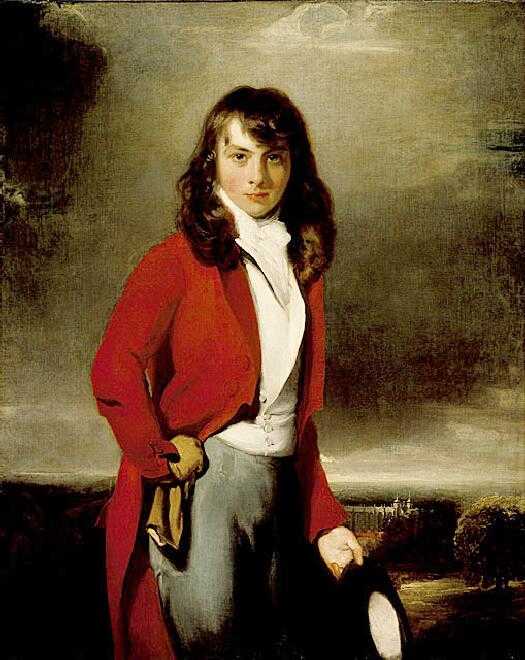
Sir Thomas Lawrence--Portrait of Arthur Atherly (England, 1791)

Figure 1.--This portrait by Sir Thomas Lawrence is of Arthur Atherley as an Etonian. We know nothing about Arhur, but attending Eton at the time and being painted by Larence suggests he came from a wealthy family. The portrait is especially interesting because it shows an Eton boy before the better-known school uniform was adopted in the early 19th century. Note in particular the bright red coat a nd long hair.
|
|
This portrait by Sir Thomas Lawrence is of Arthur Atherley as an Etonian. We do not know much about Arhur, but attending Eton at the time and being painted by Larence suggests he came from a wealthy family. An Etonian of course means a boy attending Eton College. This is a public (meaning private) school located in Eaton near Windsor Castle. The location near the Castle provided an association with the Royal family. Eton is probably the most famous school in the world. Plantagenet King Henry VI founded the school (1440). Henry was known as the "Scholar King". Henry's purpose was to provide free education for 70 poor scholars who would continue their education at King’s College, Cambridge--also founded by King Henry. A connection between Eton and Cambridge still continues today.
Eton is now an independent boarding school for boys between the ages 13-18. Some of the most famous English leaders attended England. They included military commanders, writers, explorers and politicians. Individuals included the Duke of Wellington, Shelley, Robert Boyle, George Orwell and Ian Fleming. Atherley in the portrait here stands with Eton College in the distant background. Atherley who graduated from Eton in 1791 is presented as both confident and having acquired both an education and social graces. Lawrence's portrait seems to present Atherly as almost an educated ideal--exactly what Eton strive to produce. There is no hint of criticism of the elite which governred Britain t the ime. Atherly who was about to finish at Eton is shown as both civilized as a result of his education, confident that he is prepared to succeed in life. The portrait is especially interesting because it shows an Eton boy before the better-known school uniform was adopted in the early 19th century. Note in particular the bright red coat and long hair.
This portrait by Sir Thomas Lawrence, one of the greatest of the British portrait painters. This child prodigy and largely self-taught artist became the fashionable portrait painter of his day. On the death of Sir. Joshua Reynolds in 1792, he was made principal painter to King George III, who knighted him in 1815. Lawrence is especially noted for his children's portraits for which he was unsurpassed in his day. His portraits of artistocratic or wealthy children provide a rich source of information on fashionable children's wear of the day.
Arthur Atherly (1772- )
Arthur was the oldest son of Arthur Atherley of Southampton. He was born in 1772. Arthur Atherley is painted by Lawrence as an Etonian. We do not know much about Arhur, but attending Eton at the time and being painted by Larence suggests he came from a wealthy family. Atherley in the portrait here stands with Eton College in the distant background. Atherley who graduated from Eton in 1791 is presented as both confident and having acquired both an education and social graces. Lawrence's portrait seems to present Atherly as almost an educated ideal--exactly what Eton strive to produce. There is no hint of criticism of the elite which governred Britain at the time. Atherly who was about to finish at Eton is shown as both civilized as a result of his education, confident that he is prepared to succeed in life. He went on to study at Trinity College, Cambridge. He then persued a career in banking and politics. He was elected to Parliament.
An Etonian of course means a boy attending Eton College. This is a public (meaning private) school located in Eaton near Windsor Castle. The location near the Castle provided an association with the Royal family. Eton is probably the most famous school in the world. Plantagenet King Henry VI founded the school (1440). Henry was known as the "Scholar King". Henry's purpose was to provide free education for 70 poor scholars who would continue their education at King’s College, Cambridge--also founded by King Henry. A connection between Eton and Cambridge still continues today. Eton is now an independent boarding school for boys between the ages 13-18. Some of the most famous English leaders attended England. They included military commanders, writers, explorers and politicians. Individuals included the Duke of Wellington, Shelley, Robert Boyle, George Orwell and Ian Fleming.
Clothing
The portrait is especially interesting because it shows an Eton boy before the better-known school uniform was adopted in the early 19th century. Note in particular the bright red coat and long hair.
HBC

Navigate the Boys' Historical Clothing artistic pages:
[Return to the Main Lawrence page]
[Return to the Main artistic page]
[Chronologies]
[Individuals]
[National]
[Styles]
Navigate the Boys' Historical Clothing Web Site:
[Return to the Main Eton College page]
[Introduction]
[Activities]
[Biographies]
[Chronology]
[Clothing styles]
[Countries]
[Bibliographies]
[Contributions]
[FAQs]
[Glossaries]
[Images]
[Links]
[Registration]
[Tools]
[Boys' Clothing Home]
Created: 8:08 PM 6/12/2007
Last updated: 8:08 PM 6/12/2007



